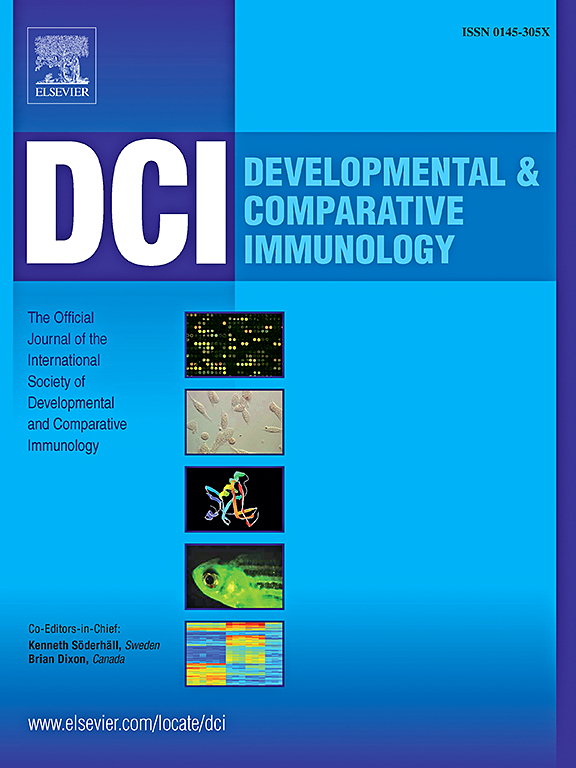β-hydroxybutyrate restricts glycolytic metabolism in bovine neutrophils during toll-like receptor 2/1 stimulation
IF 2.4
3区 农林科学
Q1 FISHERIES
引用次数: 0
Abstract
Ketosis commonly affects high-producing dairy cows during the peripartum and peak lactation periods and is associated with immunosuppression. Elevated blood levels of β-hydroxybutyrate (β-OHB), the primary ketone body, have been linked to impaired neutrophil bactericidal activity, potentially explaining the increased susceptibility to mammary and uterine infections. Since neutrophils primarily rely on glycolysis for energy, this study investigated the effects of high β-OHB concentration on the energy metabolism of bovine neutrophils stimulated with the toll-like receptor 2/1 (TLR2/1) agonist Pam3CSK4. At both subclinical (2.5 mM) and clinical (5.0 mM) ketosis concentrations, β-OHB strongly narrowed glycolytic flux and glycolytic ATP production in unstimulated cells, accompanied by reduced extracellular glucose uptake without changes in glycogen content. TLR2/1 stimulation robustly enhanced glycolysis and ATP production, upregulated glycolytic enzyme expression, promoted the translocation of glucose transporters (GLUTs) 1 and 3, boosted extracellular glucose uptake, and decreased glycogen concentration. These changes were accompanied by increased glycogen phosphorylase (PYGL) phosphorylation over glycogen synthase (GYS1) and the activation of protein kinase B (Akt), glycogen synthase kinase 3 beta (GSK3β), and protein kinase A (PKA) pathways. However, preincubation with 2.5 and 5.0 mM β-OHB attenuated these metabolic responses, reducing glycolytic flux, ATP production, glycolytic enzyme expression, GLUTs translocation, and extracellular glucose uptake, while glycogen stores remained stable. Notably, β-OHB did not impact the phosphorylation of PYGL, GYS1, GSK3β, or PKA substrate, but it did decrease Akt phosphorylation at 5.0 mM. These results suggest that elevated β-OHB concentrations restrict glycolytic metabolism in bovine neutrophils, compromising their bioenergetics and potentially contributing to impaired immune competence in ketotic dairy cows.
β-羟基丁酸盐在toll样受体2/1刺激下限制牛中性粒细胞糖酵解代谢
酮症通常影响围产期和泌乳高峰期的高产奶牛,并与免疫抑制有关。主要酮体β-羟基丁酸(β-OHB)的血液水平升高与中性粒细胞杀菌活性受损有关,这可能解释了对乳腺和子宫感染的易感性增加。由于中性粒细胞主要依靠糖酵解获得能量,本研究探讨了高β-OHB浓度对toll样受体2/1 (TLR2/1)激动剂Pam3CSK4刺激牛中性粒细胞能量代谢的影响。在亚临床(2.5 mM)和临床(5.0 mM)酮症浓度下,β-OHB在未受刺激的细胞中强烈地缩小了糖酵解通量和糖酵解ATP的产生,伴随着细胞外葡萄糖摄取减少,而糖原含量没有变化。TLR2/1刺激显著增强糖酵解和ATP的产生,上调糖酵解酶的表达,促进葡萄糖转运蛋白(GLUTs) 1和3的易位,促进细胞外葡萄糖摄取,降低糖原浓度。这些变化伴随着糖原合成酶(GYS1)上糖原磷酸化酶(PYGL)磷酸化增加以及蛋白激酶B (Akt)、糖原合成酶激酶3β (GSK3β)和蛋白激酶A (PKA)途径的激活。然而,2.5 mM和5.0 mM β-OHB预孵化会减弱这些代谢反应,降低糖酵解通量、ATP产生、糖酵解酶表达、GLUTs易位和细胞外葡萄糖摄取,而糖原储存保持稳定。值得注意的是,β-OHB不会影响PYGL、GYS1、GSK3β或PKA底物的磷酸化,但会降低5.0 mM时Akt的磷酸化。这些结果表明,升高的β-OHB浓度限制了牛中性粒细胞的糖酵解代谢,影响了它们的生物能量,并可能导致酮症奶牛的免疫能力受损。
本文章由计算机程序翻译,如有差异,请以英文原文为准。
求助全文
约1分钟内获得全文
求助全文
来源期刊
CiteScore
6.20
自引率
6.90%
发文量
206
审稿时长
49 days
期刊介绍:
Developmental and Comparative Immunology (DCI) is an international journal that publishes articles describing original research in all areas of immunology, including comparative aspects of immunity and the evolution and development of the immune system. Manuscripts describing studies of immune systems in both vertebrates and invertebrates are welcome. All levels of immunological investigations are appropriate: organismal, cellular, biochemical and molecular genetics, extending to such fields as aging of the immune system, interaction between the immune and neuroendocrine system and intestinal immunity.

 求助内容:
求助内容: 应助结果提醒方式:
应助结果提醒方式:


